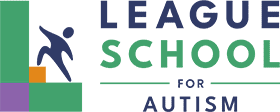The Meat and Potatoes of Communication: How we are using core vocabulary to build language across our daily routines!
Here at The League School of Greater Boston, we have so many awesome students using augmentative and alternative communication (AAC) strategies to communicate. One of the methods we use to assist our students in developing the language and skills necessary to utilize their respective devices is known as core vocabulary. Core vocabulary is a small set of words that make up 80% of our daily communication. This fact stands true for all individuals regardless of communication method (e.g., using verbal speech, picture exchange, high-technology devices, etc.), age, or gender. Core vocabulary words apply across virtually all environments and contexts. Examples of core words include “go”, “stop”, “in”, “I”, “different”, and so many more. Core vocabulary truly is the “meat” of our daily communication because these words carry the most “weight”! Which words make up the “potatoes” of our daily communication, then? Fringe vocabulary words! Fringe vocabulary refers to words that are highly specified to certain topics or contexts. Typically, these words are nouns (e.g., “witch”, “cheeseburger”, “hygiene”, etc.) and make up thematic categories (e.g., holidays, seasonal activities, etc.). For students using AAC strategies, we have started a Core Word of the Week in some of our classrooms. Each week we introduce a new core word in a structured teaching activity and then move to modeling this core word within natural language and contexts. Our first week we learned about the word “go” during gross motor movement (“go on swing”, “go fast!”), social interactions (“I go”, “you make go”), structured play, shared reading (Go, Dog, Go!), and even during transitions (e.g., “go on bus”, “go outside”)! The following week we learned about the word “in”, and this week we are learning about “play”. Our focus each week, and throughout the school year, is to teach our students vocabulary words within their AAC strategies that give them the freedom and power to communicate using meaningful vocabulary and for a variety of reasons (e.g., to request, protest, direct another person’s actions, etc.) throughout their daily routines.
